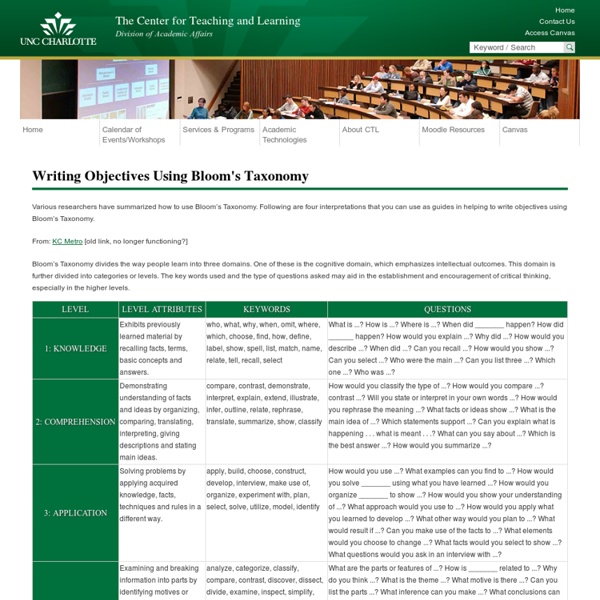IEP Goal Bank
This IEP GOAL BANK is the place where you can "deposit" your own IEP goals/objectives and "withdraw" the goals/objectives contributed by others. Few things cause more angst in our profession than writing IEP goals/objectives! One way to simplify the process is to use the template below.
Goals, Objectives and Outcomes › Assessment Primer › Assessment › University of Connecticut
Beginning in 1948, a group of educators undertook the task of classifying education goals and objectives. The intention was to develop a classification system for three domains: Cognitive domain (intellectual capability, mental skills, i.e., Knowledge) Affective domain (growth in feelings, emotions, or behavior, i.e., Attitude) Psychomotor domain (manual or physical skills, i.e., Skills) This taxonomy of learning behaviors can be thought of as the goals of training; i.e., after a training session, the learner should have acquired new skills, knowledge, and/or attitudes.
IEP Goals for Behavior Plans
Behavioral Goals may be placed in an IEP when it is accompanied by a Functional Behavioral Analysis (FBA) and Behavior Improvement Plan (BIP) . An IEP that has behavioral goals should also have a behavioral section in the present levels, indicating that behavior is an educational need. If the behavior is one that could be handled by changing the environment or by establishing procedures, you need to attempt other interventions before you alter an IEP.
Lettrs Encourages Thoughtful Digital Writing And A Slower Communications Movement
Not everything in the life of a student should be done faster, especially when taking the time to write a meaningful or thoughtful letter . But technology has let students down here. The communication of many kids has become wildy fragmented, thoughtlessly fast, with social communication and mobile platforms seeking quantity instead of quality. Students are being encouraged – conditioned in fact – by many social platforms to like, comment, tweet, text, or send at communication speeds that are more akin to a reflex rather than a well-composed expression of thought and ideas. This communication acceleration has created new challenges in both literacy and attention.
» Use the Pygmalion Effect to Create a High Performing Team the awesome culture blog
“High expectations are the key to everything.” - Sam Walton The Pygmalion Effect Study In the 1960s, Harvard psychology professor Robert Rosenthal teamed up with South San Francisco elementary school principal Lenore Jacobson to conduct what later became known as the Pygmalion Effect study. In the study, 20% of the students within each of 18 elementary school classrooms were randomly assigned to a ‘high achiever’ group, with the remaining 80% serving as the control group. The teachers in those classrooms were told that these particular students in the ‘high achiever’ group had a superior IQ; even though the students were in fact chosen at random.
Instructions: Student Learning Outcomes (SLOs)
DISCLAIMER: Some of this data in this section is fictitious and does not, in any way, represent any of the programs at Gallaudet University. This information is intended only as examples. Writing Effective Program-Level Student Learning Outcomes (SLOs)
7 Good Sources of Creative Writing Prompts
For some students the hardest part of starting a creative writing assignment is generating an idea to write about. Here are seven good sources of writing prompts that you can share with your students. The Imagination Prompt Generator randomly generates prompts for starting a fictional story. Imagination Prompt Generator is part of the Creativity Portal which offers ideas for free creative projects. Most of the project ideas in the kids section of the Creativity Portal are appropriate for elementary school and possibly middle school age students.
Teachers' Expectations Can Influence How Students Perform : Shots - Health News
hide captionTeachers interact differently with students expected to succeed. But they can be trained to change those classroom behaviors. iStockphoto.com Teachers interact differently with students expected to succeed. But they can be trained to change those classroom behaviors. In my Morning Edition story today, I look at expectations — specifically, how teacher expectations can affect the performance of the children they teach.
Bloom's Rose
Cancel Edit Delete Preview revert Text of the note (may include Wiki markup) Could not save your note (edit conflict or other problem). Please copy the text in the edit box below and insert it manually by editing this page.



